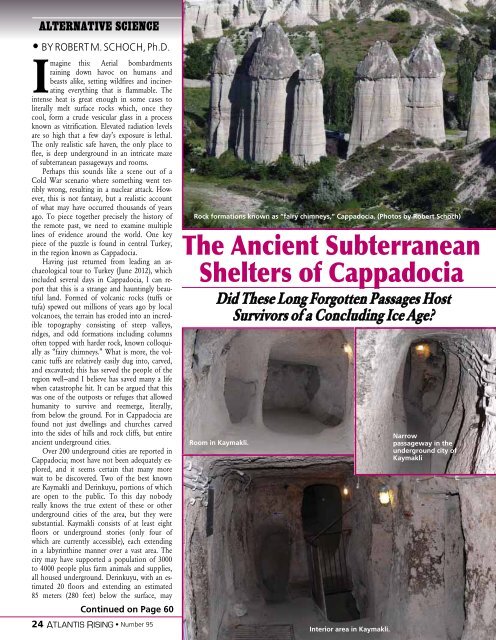Do We Know What We Think We Know About ... - TheUFOStore.com
Do We Know What We Think We Know About ... - TheUFOStore.com
Do We Know What We Think We Know About ... - TheUFOStore.com
Create successful ePaper yourself
Turn your PDF publications into a flip-book with our unique Google optimized e-Paper software.
ALTERNATIVE SCIENCE<br />
• BY ROBERT M. SCHOCH, Ph.D.<br />
Imagine this: Aerial bombardments<br />
raining down havoc on humans and<br />
beasts alike, setting wildfires and incinerating<br />
everything that is flammable. The<br />
intense heat is great enough in some cases to<br />
literally melt surface rocks which, once they<br />
cool, form a crude vesicular glass in a process<br />
known as vitrification. Elevated radiation levels<br />
are so high that a few day’s exposure is lethal.<br />
The only realistic safe haven, the only place to<br />
flee, is deep underground in an intricate maze<br />
of subterranean passageways and rooms.<br />
Perhaps this sounds like a scene out of a<br />
Cold War scenario where something went terribly<br />
wrong, resulting in a nuclear attack. However,<br />
this is not fantasy, but a realistic account<br />
of what may have occurred thousands of years<br />
ago. To piece together precisely the history of<br />
the remote past, we need to examine multiple<br />
lines of evidence around the world. One key<br />
piece of the puzzle is found in central Turkey,<br />
in the region known as Cappadocia.<br />
Having just returned from leading an archaeological<br />
tour to Turkey (June 2012), which<br />
included several days in Cappadocia, I can report<br />
that this is a strange and hauntingly beautiful<br />
land. Formed of volcanic rocks (tuffs or<br />
tufa) spewed out millions of years ago by local<br />
volcanoes, the terrain has eroded into an incredible<br />
topography consisting of steep valleys,<br />
ridges, and odd formations including columns<br />
often topped with harder rock, known colloquially<br />
as “fairy chimneys.” <strong>What</strong> is more, the volcanic<br />
tuffs are relatively easily dug into, carved,<br />
and excavated; this has served the people of the<br />
region well—and I believe has saved many a life<br />
when catastrophe hit. It can be argued that this<br />
was one of the outposts or refuges that allowed<br />
humanity to survive and reemerge, literally,<br />
from below the ground. For in Cappadocia are<br />
found not just dwellings and churches carved<br />
into the sides of hills and rock cliffs, but entire<br />
ancient underground cities.<br />
Over 200 underground cities are reported in<br />
Cappadocia; most have not been adequately explored,<br />
and it seems certain that many more<br />
wait to be discovered. Two of the best known<br />
are Kaymakli and Derinkuyu, portions of which<br />
are open to the public. To this day nobody<br />
really knows the true extent of these or other<br />
underground cities of the area, but they were<br />
substantial. Kaymakli consists of at least eight<br />
floors or underground stories (only four of<br />
which are currently accessible), each extending<br />
in a labyrinthine manner over a vast area. The<br />
city may have supported a population of 3000<br />
to 4000 people plus farm animals and supplies,<br />
all housed underground. Derinkuyu, with an estimated<br />
20 floors and extending an estimated<br />
85 meters (280 feet) below the surface, may<br />
Continued on Page 60<br />
24 ATLANTIS ATLANTIS RISING RISING • Number 95<br />
Rock formations known as “fairy chimneys,” Cappadocia. (Photos by Robert Schoch)<br />
������������������������<br />
����������������������<br />
Did Did These These Long Long Forgotten Forgotten Passages Passages Host Host<br />
Survivors Survivors of of a a Concluding Concluding Ice Ice Age? Age?<br />
Room in Kaymakli.<br />
Narrow<br />
passageway in the<br />
underground city of<br />
Kaymakli<br />
Subscribe or Order Books, DVDs and Much More!<br />
Interior area in Kaymakli.


